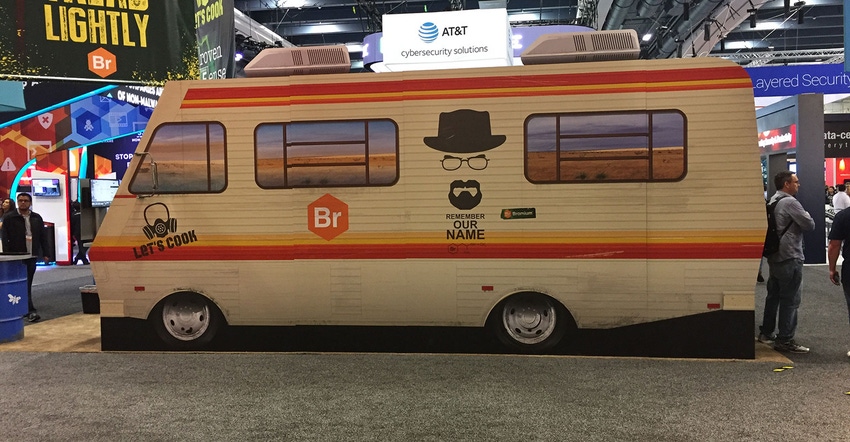This article is not about making or smuggling drugs using the IoT. If that's what brought you here, turn back. I don't even let my kids download music or movies for free, so that should clue you on where this is going!
February 15, 2017

By Kshitish Soman
Let me start with a story. In December of 2012, at the height of Furby madness, a few of my friends and I were having drinks around Christmas time. We were a bit liquored up and amazed at the new Furby toy’s ability to respond wirelessly to the iOS app. Our minds quickly veered off to making vibrating toys that can be remotely controlled via a smartphone. Trust me, that’s a dead end. However, within days, I was immersed in researching remote control stuff online, buying hardware and making little projects from kits like the Arduino open source platform. Over the years, I have built many different things using widely different hardware and software platforms. When somebody tells you it costs less than $100 to build an Internet of Things device at home, believe them. It can be done.
I’ve followed the IoT space for long enough to see that it offers tremendous career opportunities. But the IoT can also seem vast and chaotic, making it difficult to get a clear sense of where the opportunities are. Most people have a bad time breaking into the IoT industry. (See what I just did there with that reference to the TV series Breaking Bad? If you haven’t watched the series, don’t worry. You’ll still understand this article.) You would be forgiven for thinking that the technology is moving so quickly, you’ve already missed out. That seems to be a common assumption. In fact, I was speaking to a young college graduate just this weekend talking about my interest in the IoT and the first question she asked me was: “Did I miss the bus?”
No, she hasn’t. And you probably haven’t either. We are in the infancy of the IoT in many ways. It’s like it’s 1995 all over again. I like that year. I was young, and so was the Internet. Working in the tech field in the mid-1990s was exciting because it seemed like the Internet offered limitless potential. With the Dot Com bust and all, it was a rocky road though for some of the people in that field. But if that has taught us anything, it’s that we should balance idealism with pragmatism. We should have a clear sense of what type of work opportunities—and challenges—a nascent new technology like IoT offers.
Like almost any other broad-based technology, the IoT will spawn new work opportunities in just about all spheres of life. Companies will need people who build, test, deploy, and support the actual technology. And they’ll need people who count the beans, manage the talent, and sell things. But this article is mostly for people who are going to deal with the technology directly—who work with the hardware, software, security, and that kinda stuff. The other job functions are more or less similar to most other tech companies and if all you need is a primer, then I suggest, shamelessly, my IoT primer article.
Step 0: Don’t Use IoT Technology for Drug Trafficking
In case you didn’t see my warning at the top of this article, it’s a terrible idea to use IoT technologies to break the law. Yes, there are already reports of criminals using drones to smuggle drugs and there are probably people who have set up IoT-enabled meth labs. If Breaking Bad’s meth kingpin Walter White were still operating in 2017, he’d probably do the same. But you need a better role model than that.
Step 1: Put Your Enthusiasm in First Gear and Just Jump In
It seems, there is almost nothing you can’t do with an IoT kit right now. It may not look as sexy as the Nest thermostat, but if it did, you should be in the design industry anyway, not tech.
To get a sense of what is hot in IoT now, just fire up your favorite search engine and go hunting. Don’t bother investing in fancy dead-tree edition books. The story is still being written on the IoT and almost anything you read in print will be obsolete before you toast your bread and smother it with Irish butter. Online resources are king. There’s fresh material online everyday, and some of it is very, very useful.
Step 2: Don’t Bite into the Pi, at Least Not Yet
I know a lot of people tell you that the yummy Raspberry Pi is an excellent starter IoT platform. Well, it is and it isn’t. It’s a great starter platform to do serious stuff. But when you are trying to do something in between a “Hello World” program and something more advanced, you need to find a kit that’s extremely easy to use, versatile, and has tremendous online free support.
I strongly suggest you look at the Arduino ecosystem. It offers excellent cheap hardware, a very simple C-like programming language, and, most importantly, lots of support from hobbyists and third parties. This support extends from software to hardware components, including sensors, actuators, processors, and so much more. The number of free code snippets you will find online is mind-boggling. I started my hardware and software experimentation on Arduino, and I absolutely recommend that even the most seasoned programmers out there do the same. Would you rather build your first project in 12 hours or 5 days? Trust me, the positive reinforcement and ego boost you’ll feel after those 12 hours will be worth far more than the 50 bucks you’d have spent.
Step 3: Keep Experimenting
The more hobby projects I did, the more I learned. Of course, that’s how it works for all. The first couple of simple projects will be easy. However, you will quickly realize, that, in the world of the IoT, you need to understand deeply the interplay between hardware and software. As you tackle more complex use-cases, you’ll realize conceptually trivial problems can turn into really challenging implementation hacks. While ultimately you may gravitate to a niche area of the IoT, early on, take on challenges of hobby building entire projects. Experiment with different chipsets, programming platforms, learn why there is so much buzz about cloud computing, AI etc. Absorb all this, and fast.
Step 4: Collaborate and Network
Assuming you are really into this, you’ll be at this point in about two months or under. Doing really challenging projects will force you to collaborate and network. Your first stop will be online, but your next stop may be collaborating with others driven by the same interests as you. I did a lot of collaboration projects with Sameer & Nash. Both excellent techies that i’ve known for a while. It’s like doing projects in school. Collaboration and networking help you broaden your thinking and also helps you overcome challenges along the way. Also, use the time to network in the broader community, especially online. When I was in school, networking was limited to subscribing to IEEE or what was immediately around me in schools and colleges. Now, the world is literally a village, use it to your advantage. Oh, Walter White, the hero of Breaking Bad, serves as a good example of how not to collaborate and network. The moral of that story is that collaborating with a drug-addled gangster wannabe is a bad idea. Put differently: You should be careful in choosing who to partner with—if you pick the wrong ones, don’t be surprised if the DEA is on your tail.
Step 5: Specialize
Once you have got past the basics of learning your way around the IoT, it’s time to start to figure out your niche, your strength, and areas of specialization. My collaboration with two colleagues Sameer and Nash was enlightening in many ways. I’ve known Sameer since college and Nash for close to a decade now. While I veered more towards conceptual architecture and green field imagination in my technology endeavours, Sameer is more of a hands on technical leader. Nash, on the other hand, has spent almost all his life running with startups and has a can-do-anything ground floor mentality that brings tremendous energy and push to projects we have undertaken. When we did our little collaboration projects, we all started to identify niche areas where we were more effective and useful. Just like we did, you should figure out, if you love the edge, the cloud, networking, hardware platforms, and so on. I can’t resist bringing up our Breaking Bad meth-cook anti-hero, Walter White into this again. Walt separated his product from the market with crystal meth so pure it was blue. While that may make for good TV, you might want to consider others ways to differentiate yourselves here.
Step 6: Take the Leap
Alright, take the leap. Have faith in yourself. If you run into an expert out there, trust me, they just got a little bit of a head start. Remember what I said earlier, today, in 2017, we are where the internet was in 1995. It’s got a long ways to go. Just trust yourself and dive in. Both large firms and startups are involved in the IoT space. You will find information fast using online resources. Network online via traditional places such as Linkedin, or, join local meetup groups, attend local networking events specifically geared to IoT, and attend events, conferences, etc. Remember, job search costs can be tax deductible.
Good luck. Just like Walter White, you are going to say, “I won” someday. Or, if you get mixed up with the bad guys, you’ll say “I Better Call Saul!”
You can follow me on Twitter @ksoman for my ongoing IoT banter or email me if you have nice things to say.
You May Also Like
.jpeg?width=700&auto=webp&quality=80&disable=upscale)
.png?width=700&auto=webp&quality=80&disable=upscale)



.png?width=300&auto=webp&quality=80&disable=upscale)
